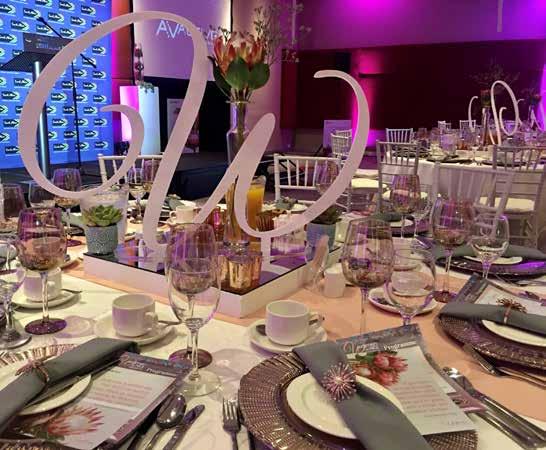
4 minute read
Tailor your events like a boss
TAILOR AN EVENT LIKE A BOSS
Meetings has been on a mission to bring you some top tailoring tips .
Advertisement
#3
TAILOR This is where you can really go to town – from logos and graphics for branding to meeting tools and sourcing speakers and entertainment. Aim to create a seamless experience for delegates from the get-go with an online registration process, website and mobile app that is downloadable ahead of the event, and roll out a social media campaign that engages and informs. Have a plan in place for on-arrival kiosks and information desks during the event and think about how you can create a buzz around photos and videos with social walls and video booths.
# 1 #2
MEASURE During this initial process, discuss the purpose of the event with your client and team. Build out your concept or theme and start reviewing budgets and timelines that also include a roadmap for engaging with your attendees and what ROI or metrics will be used to determine the success of the event.
#4
HAIR DONE Leading up to the event, have a final production meeting to go over what on-site logistics must be factored in and who is responsible for managing which aspect of the event coming together. Ensure that all terms have been met with your service providers and confirm bookings for accommodation and transport. Bed down your show flow and engage with speakers and any other VIPs on their requirements.
CUT Your event design will be heavily hinged on venue sourcing and/or site selection. This is also when you will need to start identifying service providers for the elements that make an event an event: audiovisual, catering, decor and on-the-ground staff such as security, which will also form part of your safety and security planning. Identifying possible sponsors for these aspects will also help your budget.
#5
CHECK MY NAILS Post event, you will need to reconcile all your invoices and payments and produce an analysis on the budget and spending. For your client, show ROI and for delegates, consider something like a resources booklet or section on your website with surveys and reporting on the metrics for better future planning.
LOCAL TRANSFORMATION ON A GLOBAL SCALE
The MICE and greater tourism industries are representative of our country, but let’s look at transformation from a broader perspective and not just a local, South African viewpoint, encourages Thami Nkadimeng.

In the last edition, we touched on the new decade upon us and the innovation and technology needed to achieve the Industry 4.0 vision.
Using the analogy that no meal can be cooked without a chef, the requirements and delivery to reach our tourism goals for the next decade need to be fulfilled by our people. Not just warm bodies but rather, intelligent and capable beings with varying capacities, experiences, skills and, especially, thought processes.
It is encouraging to see that issues such as gender, race and economic status within transformation are receiving attention, as this ensures a holistic and encompassing view that history may have previously omitted.
As an industry, tourism is a
representative of our country and we need to look at transformation from a
TRANSFORMATIVE STEPS I found it profound to borrow the next steps of transformation from a maths geometry theory, considering that the words used in this theory have a
direct description, overtone and undertone to the
transformation we refer to in tourism.
First, let us discuss the theory of rotation; in maths, this
requires movement of a shape in either a clockwise or anticlockwise direction. To have an effect and propel us forward, we need to understand the changing facets around us and implement
transformation with revolving
pieces in mind. Second, there is the notion of reflection – we need to reflect on the strides we have taken previously and make a decisive but settling decision on whether the methods used in the past are indeed working for us, or whether we need to rethink this. In order to do so, we need to look at the tools required, such as language and communication skill sets, as well as the mindsets of individuals and talent gaps while appreciating all that embraces diversity.
ENSURING EFFICACY For transformation within tourism to be effective, we need to look at the direction of our partners and investors and ensure our objectives are aligned. Conversely, as an industry, it is imperative we map out the stakeholders who have an influence on our objectives and move together with them in a similar direction. We cannot even begin to consider transformation without inclusive growth of everyone – from key global players to our local communities, we need to consider how the growth affects all stakeholders for it to be inclusive. The transformation phase is not an easy one; it is not quite black and white… but the grey parts leave room for greater innovation. This phase is necessary for the reputation of the industry, both locally and internationally, and different perspectives increase creativity. With diverse outlooks and frames of mind, it is inevitable that there would be better solutions, resulting in increased profits.
Given the impact of tourism, diversity carries a lot of gravity because, while many hands make light work, without diversity, how can we truly understand if this is working effectively to impact all?
An experienced writer, speaker, moderator and MC, Thami Nkadimeng is a message architect who conceptualises, creates and delivers messages to a wide range of audiences, across borders and boundaries, using a variety of tools and platforms to reach objectives set. For opportunities with Thami, contact her on thami@thaminkadimeng.com.










